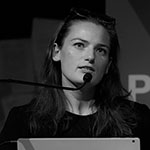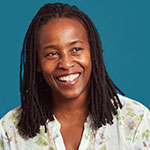Das Panel konzentriert sich auf die Einschränkungen und Unsicherheiten, mit denen KünstlerInnen im Umgang ihrer künstlerischen Praxis mit KI konfrontiert sind. Was sind die Herausforderungen der Zusammenarbeit an der Schnittstelle zwischen KI und Kunst? Welche Fortschritte lassen sich erkennen, und wo scheitert sie? Mit welchen Problemen sehen sich KünstlerInnen konfrontiert? Welche Rahmenbedingungen müssen geschaffen werden, damit KünstlerInnen Zugang zu den neuesten Forschungsergebnissen erhalten? Dieses Panel wird Erkenntnisse von führenden ExpertInnen auf diesem Gebiet sammeln, um neue Entwicklungen und Möglichkeiten kritisch zu diskutieren.
Moderation: Jurij Krpan (SL)
Speaker: Christl Baur (DE/AT), Suzanne Livingston (UK), Špela Petrič (SL), Stephanie Dinkins (US)
Video
Projekt Credits
This event is realized as part of the European ARTificial Intelligence Lab and co-funded by Creative Europe Programme of the European Union.
Biographies

Christl Baur (DE/AT)
Christl Baur is Head of Ars Electronica Festival, researcher with an interdisciplinary background in art history, cultural management, and natural science. She is particularly interested in the conjunction of aesthetic and social practices that center on collaboration and experimentation and challenge dominant social, political, and economic protocols. Her research field encompasses topics such as video art, new media technologies, computer art, biotechnology and interactive art, and she works at the nexus of art & science.

Stephanie Dinkins (US):
Stephanie Dinkins is a transmedia artist and professor at Stony Brook University where she holds the Kusama Endowed Chair in Art.
She creates platforms for dialog about artificial intelligence (AI) as it intersects race, gender, aging, and our future histories. She is particularly driven to work with communities of color to co-create more equitable, values grounded artificial intelligent ecosystems. Dinkins’ art practice employs lens-based practices, emerging technologies, and community engagement to confront questions of bias in AI, data sovereignty and social equity. Investigations into the contradictory histories, traditions, knowledge bases, and philosophies that form/in-form society at large underpin her thought and art production.
Dinkins earned an MFA from the Maryland Institute College of Art in 1997 and is an alumna of the Whitney Independent Studies Program. She exhibits and publicly advocates for inclusive AI internationally at a broad spectrum of community, private, and institutional venues – by design. Dinkins is Artist in Residence at the Stanford Institute for Human-Centered Artificial Intelligence, 2019 Creative Capital Grantee as well as a 2018/19 Soros Equality Fellow, Data and Society Research Institute Fellow Past fellowships and residencies include Data and Society Research Institute Fellowship, Sundance New Frontiers Story Lab, Eyebeam, Pioneer Works Tech Lab, NEW INC, Blue Mountain Center; The Laundromat Project; Santa Fe Art Institute and Art/Omi.
The New York Times featured Dinkins in its pages as an AI influencer. Apple Inc recognized Dinkins’ research and community-centered efforts by featuring her as a local hero in their “Behind the Mac” ad campaign (Brooklyn, NY edition). Wired, Art In America, Artsy, Art21, Hyperallergic, the BBC, Wilson Quarterly, and a host of popular podcasts have recently highlighted Dinkins‘ art and ideas.

Jurij Krpan (SL)
In the year 1995, at the initiative of the Student Organisation of the University of Ljubljana he conceived the Kapelica Gallery – Gallery for Contemporary Investigative Arts, which he has been running since. As a senior curator and selector he has contributed to domestic and international festivals, the biggest international productions to date being the organization and artistic management of the Slovenian pavilion at the 50th Venice Bienale in 2003 and the conceptual gallery Cosinus BRX at the European Commission building in Brussels and the 5.th triennial of Contemporary Investigative Arts 2006 at Museum of Modern Art – Ljubljana. In September 2008 he curated the presentation of the Gallery Kapelica in the Featured Art Scene section of Ars Electronica in Linz, and in 2009 the survey of 80 years of avantgarde art in Slovenia. In 2014 he co-curate the Designing Life section for Biennial of product design in Ljubljana and co-curate the slovenian pavilion at Venice biennial for architecture. He was a juror at Prix Ars Electronica for the Hybrid Arts category in the year 2010, ’13, ’15, ‘16 and 2017. Since 2017 he is working on the sistemic sollutions for bringing artistic ideations into the process of innovation for more sustainable, safe, inclusive and ethical future. Jurij Krpan lectures about the artistic profile of the Kapelica Gallery in Slovenia as well as abroad.

Suzanna Livingston (UK):
Dr Suzanne Livingston was co-curator of the Barbican Centre’s “AI: More than Human” exhibition which ran from May to August last year, before beginning its international tour. She has spent her career researching and questioning the entwined relationship between humans, culture and technology and the philosophical consequences emerging from that. Taking a multidisciplinary approach, Suzanne has worked globally across sectors spanning technology, arts, museums, education and business. As Global Principal at Wolff Olins, Suzanne developed strategy and exhibitions internationally with museum organisations such as the V&A, Whitney, ICA Boston, Qatar Museums and Southbank Centre and also with technology companies including Sony Worldwide, Native Instruments, Playstation and Ericsson. Suzanne received her PhD in Philosophy from Warwick University and is a founding member of the influential Cybernetic Culture Research Unit (CCRU). She now works independently and continues to write collaboratively on technology, belief systems, innovation and evolution.

Spela Petric (SI)
Špela Petrič is a Ljubljana and Amsterdam based new media artist who has been trained in the natural sciences and holds a PhD in biology. Her artistic practice combines the natural sciences, wet biomedia practices, performance, and critically examines the limits of anthropocentrism via multi-species endeavours. She envisions artistic experiments that enact strange relations to reveal the ontological and epistemological underpinnings of our (bio)technological societies. Her work revolves around the reconstruction and re-appropriation of scientific methodology in the context of cultural phenomena, while working towards an egalitarian and critical discourse between the professional and public spheres. Petrič received several awards, such as the White Aphroid for outstanding artistic achievement (Slovenia), the Bioart and Design Award (Netherlands), and an Award of Distinction at Prix Ars Electronica (Austria).


